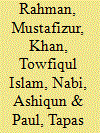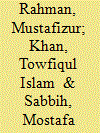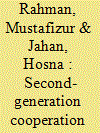|
|
|
Sort Order |
|
|
|
Items / Page
|
|
|
|
|
|
|
| Srl | Item |
| 1 |
ID:
103949


|
|
|
|
|
| Publication |
2011.
|
| Summary/Abstract |
This article investigates new opportunities that are emerging for Bangladesh with regard to her trade with India. In spite of the growing bilateral trade deficit, value of Bangladesh’s exports to India increased by about three times over the last five years. Examination of the dynamics of Bangladesh–India bilateral trade reveals that the number of products in Bangladesh’s export basket has registered significant increase, while at the same time, composition of the country’s exports to India has also shifted towards newer and non-traditional products. RCA analysis shows that export items with RCA > 1 in India, which include raw jute, chemical fertilizer, cement, RMG, leather, battery, textile fabrics and some other items, have significant export opportunities and have a combined potential market of US$ 2 billion in India. On the basis of examination of various tariff and nontariff barriers to trade with India, the article attempts to assess the economic implications of India’s sensitive list as it applies to Bangladesh, and argues that elimination of this list is not likely to have an adverse impact on India’s revenue earnings. The article also comes up with a number of recommendations to deal with the NTBs faced by Bangladesh in her trade with India, particularly in areas related to constraints arising from lack of trade facilitation.
|
|
|
|
|
|
|
|
|
|
|
|
|
|
|
|
| 2 |
ID:
168505


|
|
|
|
|
| Summary/Abstract |
The article examines the various dimensions and underlying causes of informal employment in the Bangladesh labour market and the associated wage penalty. Based on labour force survey data for successive points, we trace the dynamics of employment in Bangladesh along the informal–formal divide over time. Given that wage differential remains a key feature concerning the two market segments, we have carried out mean and quantile decomposition exercises to estimate the wage penalty originating from informality. We find significant wage gaps between formal- and informal-paid employees, formal paid and informal day labour, and formal paid and informal self-employed. The wage gaps range between 65.0 per cent and 225.0 per cent. The gap arises from a combination of observed differences in human capital and job characteristics, and the wage premium accruing from formal employment.
|
|
|
|
|
|
|
|
|
|
|
|
|
|
|
|
| 3 |
ID:
178435


|
|
|
|
|
| Summary/Abstract |
The number of people aged more than 60 in Bangladesh is projected to constitute 20% of total population by 2051. The demographic momentum makes it necessary to pursue policies that guarantee a secured life for the country’s senior citizens. Currently, more than 40% of old age population (more than 65 years) in Bangladesh do not receive any type of pension or social security benefits. In this backdrop, introduction of a universal pension scheme (UPS) is an idea that should merit serious consideration. The idea of a UPS is also aligned with several Sustainable Development Goals (SDG) targets. Based on the International Labour Organization multi-pillar pension model, the article deals with required financing under different scenarios of introducing UPS in Bangladesh. The study estimates that for introducing a non-contributory UPS in Bangladesh, it would require an additional average allocation equivalent to 0.1%–0.5% of gross domestic product per annum between now and 2040. The article also estimates financing needs considering two options for the contributory UPS. The article concludes that UPS in Bangladesh can be launched on a limited scale which then could be expanded in scope and coverage in a gradual and phased manner. The article also underscores that introduction of UPS will create opportunities to rationalize the existing safety net programmes that will release funds for underwriting the UPS.
|
|
|
|
|
|
|
|
|
|
|
|
|
|
|
|
| 4 |
ID:
165370


|
|
|
|
|
| Summary/Abstract |
This article undertakes an examination of Bangladesh’s latest available Quarterly Labour Force Survey 2015–2016 data to draw in-depth insights on gender wage gap and wage discrimination in Bangladesh labour market. The mean wage decomposition shows that on average a woman in Bangladesh earns 12.2 per cent lower wage than a man, and about half of the wage gap can be explained by labour market discrimination against women. Quantile counterfactual decomposition shows that women are subject to higher wage penalty at the lower deciles of the wage distribution with the wage gap varying between 8.3 per cent and 19.4 per cent at different deciles. We have found that at lower deciles, a significant part of the gender wage gap is on account of the relatively larger presence of informal employment. Conditional quantile estimates further reveal that formally employed female workers earn higher wage than their male counterparts at the first decile but suffer from wage penalty at the top deciles.
|
|
|
|
|
|
|
|
|
|
|
|
|
|
|
|
| 5 |
ID:
139479


|
|
|
|
|
| Summary/Abstract |
South Asia remains one of the least integrated regions in the world, which is manifested in its lack of connectivity, low levels of intra-regional trade and weak investment flows. On the other hand, there is an apprehension that Southeast and East Asia could fall into a ‘middle income trap’, if they are not able to raise competitive strength and productivity further. In view of this, it is argued that there is a need for a framework of second-generation cooperation and integration embracing these three subregions in Southern Asia. This calls for concerted efforts to leverage existing institutional arrangements and put in place new avenues of subregional and inter-regional cooperation. Expansion of production networks, developments of value chains and greater integration of markets will allow these subregions to translate their respective comparative advantages into competitive advantages. Through harnessing opportunities of technology transfer, connectivity and greater factor mobility, and by taking advantage of cross-regional division of labour, these subregions could promote new patterns of inter-regional trade structure and specialization, which could benefit all the countries of Southern Asia.
|
|
|
|
|
|
|
|
|
|
|
|
|
|
|
|
|
|
|
|
|